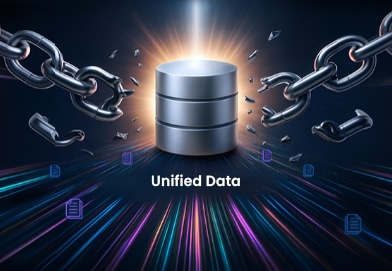Data is the lifeblood of your eCommerce business. It is an asset that needs to be managed, protected, and leveraged to drive your success. However, if you don’t have a handle on the full scope of data in your organization and where it comes from, you will not be able to harness its true power. In this post, we’ll share 10 best data management practices and examples from leading companies doing it right!
Understand The Kind of Data You Have and Where it Comes From
Before you can use your data to make smarter business decisions, you need an understanding of what kind of data you have. Knowing what information you have to work with will help you determine where it’s coming from and how to ensure it stays accurate. The integrity of your data is the basis of its value.
There are three main data types: structured, semi-structured, and unstructured.
Structured data
—such as contact info or product descriptions—is easy to organize into rows and columns because each piece has a specific format to store it in a database or spreadsheet. This information is typically gathered via forms or surveys on your website.
Semi-structured data
—such as images and videos—are also easy to store in databases because they usually follow a set pattern when presented online (for example, each image has its file name).
However, this type of information does not always come with structured metadata describing its contents (like whether the image contains text). For example, if someone uploads an image but doesn’t label what’s in it (e.g., “cat”), then there could be hundreds of cats shown in various poses throughout said photo collection without any way for anyone else looking at them to know which cat(s) were included!
Unstructured Data
This type of data can seem daunting, but IDC projections estimate that around 80 percent of your data could be unstructured data by 2025.
Unstructured data mostly comes from text files like emails or Word documents; however, unlike semi-structured formats, there are still some guiding principles you can follow about how those files should be organized. We’ll get into the organization next.
Organize Your Data
Organizing your data is critical because without proper organization, you’ll spend too much time trying to find what you’re looking for rather than doing something productive with that information once found (or worse yet: if someone else needs access to this same piece of information but can’t find it).

Structured and semi-structured data can be organized in traditional ways, with a solid schematic representation of the data types you’re storing. You may keep this type of data in a table or document, depending on the type of database you’re working with.
For organizing unstructured data, the picture is a little different. You’ll need to understand what value you hope to extract from the data and apply the appropriate processes. Often, you can use natural language processing to remove measures of sentiment, keywords, and classification that can then be used to impose a type of organization. Another thing to remember is that depending on your data, you may need more specialized systems for organization, including taxonomic hierarchies or ontological models.
Look at your favorite big commerce website to see this in action. If you are looking for a set of wrenches, you might find associated products nested under the following categorization: Home Good / Tools / Hand Tools / Wrenches. In real terms, this helps you manage your inventory effectively and it also helps your customers find what they are looking for quickly.
Preemptively Address Data Quality Problems
Data quality issues can be challenging to predict, diagnose, and resolve. They may not occur until the end of a project or after launching your product or service.
Pre-empt data quality problems before they happen by having a process in place early in your business development cycle. This will allow you to catch potential errors before they become costly, leading to lost sales and customer dissatisfaction.
One golden standard of data quality is that the data you can trust the most is the data you have collected with a clear purpose. Another critical element in avoiding a messy data problem that seems simple but is very important and sometimes surprisingly difficult to enforce is a commitment to good naming practices. When you establish consistent naming conventions, you can avoid the need for disambiguation later.
Identify Must-Have Data for Business Needs
While some departments, such as marketing and sales, leverage the same information, others, like customer service and operations, may require different data types. How will you collect the different types of data needed by your organization’s departments? Can you avoid redundancy in your collection methods?
In addition to the type of information required by each department, you should also consider how often it’s necessary. For example, some departments might not need daily updates, while others may require real-time updates.
This will affect the types of tooling you choose to use for accessing needed data. It will also affect the protocols you put in place for how employees should ideally make requests or even serve themselves with data relevant to their department’s function.
Build a Deterministic Toolbox
A deterministic toolbox is a set of tools that can be used to ensure data quality at the source. These tools allow you to vet your data before it reaches your analytics platform and ensure it’s clean and accurate.
Every time you make the query, provided the data is the same, the answer should also be the same. Predictable and explainable processes are essential in establishing practices that ensure you can trust your data.
How do you know if your data is clean? Looking for data patterns, like duplicate or missing values, is essential. If you see those patterns on a large scale (i.e., across multiple fields), it’s probably time for some remediation efforts. We can help you with that!
6: Create a Continuous Testing Regimen for Data Integrity
It would help if you created a continuous testing regimen for the integrity of your data. Integrity translates to trust. You need to be able to trust your data. To ensure you can believe your data, define what you will test and when. Then, set up alerts that will inform you when there are problems.
Define which data types must be tested (e.g., customer profiles, product listings). Next, determine what issues will likely occur in these areas (e.g., Did someone change an address?).
You can implement all this by creating an automated script that can run through your site on its own so that you don’t have to check everything every time something happens manually.
7: Maintain a Process for Cleansing and Purging Your Data
It’s the rare eCommerce business that doesn’t have to deal with messy data. Your customers are buying and selling things, and a lot of those things change hands through your platform.
But what happens when some of these items get mistaken for someone else’s? After all, the interface between what’s in the database and what is physically on the shelf or in a shipping container can get very chaotic.
These issues can be avoided by creating an ongoing process for cleansing and purging your data. Doing this regularly, such as every few weeks or months, would be best. If you’re giving away something as part of your rewards program, it may make sense to do it more often than that so you ensure you’re giving only valid points or credits out to users who earned them.
Once the process is complete, check in with yourself on whether there’s anything else you need to clean up after this batch: maybe there was an item that was removed from inventory but still showing up as available for sale; maybe now that it’s been fixed correctly in the database, there will be a new problem—one explicitly related to how something like this happens again—that needs addressing immediately so that no customers are affected adversely by inaccurate information (and therefore end up leaving bad reviews).
Guard Your Data Like Fort Knox
Data is your most important asset as a business owner. A data breach could set you up for exploitation in obvious and not-so-obvious ways. That’s why you need to guard it like Fort Knox. Your business relies on the integrity of your data, and protecting it is critical to your company’s success.

If you don’t have a plan to protect against data breaches, you could be putting yourself at risk for fines, lost revenue, and even criminal charges.
Data security doesn’t necessarily mean hiring a team of cybersecurity experts or buying expensive hardware; many companies can manage their security needs with simple yet effective strategies like encryption and backups. See our guide to understand the basics of securing data.
Embrace a Centralized Data Philosophy
One of the best ways to ensure you’re leveraging all your available data is to embrace a centralized approach. Centralized data management helps ensure that information is being shared across departments and teams so everyone can access all relevant information when needed. This practice can also help reduce duplicate work by providing that no one person needs access to multiple sources of information to do their job.
In addition to preventing unnecessary repetition, centralized data management will help you analyze more effectively across all business areas—within each department and at the company level.
Having everything in one place makes it easier for everyone involved with managing your products or services (including sales reps) to understand how each decision impacts other parts of the business—and why those decisions were made in the first place.
Continuously Leverage and Explore the Data You Own.
If you’re not using your data to make decisions, you’re missing opportunities to create more value for your customers, improve your products and services, and grow revenue.
Data can help you provide better customer service by enabling you to know what they want so that they can always get exactly what they need and when they need it.
It’s also essential to understand how those customers interact with your brand so that when they have questions or concerns about their orders, the issues can be resolved as quickly as possible.
What Can Data Management Best Practices Provide To My Business?
Effective data management has numerous benefits for businesses, including improved decision-making, increased efficiency and productivity, enhanced data security, compliance with regulations, better customer insights, scalability, cost savings, enhanced collaboration, data quality improvement, and competitive advantage.
Work With Us
If you’re excited about the possibilities of data analysis, we encourage you to remember that it’s only as good as the data it comes from. Data quality is an ongoing process, and a great starting point is getting organized by identifying what kind of data you have and where it comes from. Then, implement some best practices so your data will be ready when you need it most—like when someone asks an important question or when your business needs to make a decision based on past performance!
Need help setting up your organization with best practices and winning strategies for extracting insight from data? That’s where we come in. You don’t need to hire a whole in-house team for this high-value work. Here at Data Sleek, we have a team of experts ready to help you do data right!








